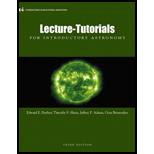
Concept explainers
Two students are looking at a brightly lit full Moon, illuminated by reflected light from the Sun. Consider the following discussion between the two students about what the spectrum of moonlight would look like.
Student 1: I think moonlight is just reflected sunlight, so we will see the Sun's absorption line spectrum.
Student 2: I disagree. An absorption spectrum has to come from a hot, dense object. Since the Moon is not a hot, dense object, it can't give off an absorption line spectrum.
Do you agree or disagree with either or both of the students? Explain your reasoning.
Trending nowThis is a popular solution!
Learn your wayIncludes step-by-step video

Chapter 3 Solutions
Lecture- Tutorials for Introductory Astronomy
Additional Science Textbook Solutions
Applied Physics (11th Edition)
Conceptual Physics: The High School Physics Program
University Physics Volume 3
The Cosmic Perspective (8th Edition)
Modern Physics
An Introduction to Thermal Physics
- Star X has lines of ionized helium in its spectrum, and star Y has bands of titanium oxide. Which is hotter? Why? The spectrum of star Z shows lines of ionized helium and also molecular bands of titanium oxide. What is strange about this spectrum? Can you suggest an explanation?arrow_forwardGo outside on a clear night, wait 15 minutes for your eyes to adjust to the dark, and look carefully at the brightest stars. Some should look slightly red and others slightly blue. The primary factor that determines the color of a star is its temperature. Which is hotter: a blue star or a red one? Explainarrow_forwardThe greenhouse effect can be explained easily if you understand the laws of blackbody radiation. A greenhouse gas blocks the transmission of infrared light. Given that the incoming light to Earth is sunlight with a characteristic temperature of 5800 K (which peaks in the visible part of the spectrum) and the outgoing light from Earth has a characteristic temperature of about 300 K (which peaks in the infrared part of the spectrum), explain how greenhouse gases cause Earth to warm up. As part of your answer, discuss that greenhouse gases block both incoming and outgoing infrared light. Explain why these two effects don’t simply cancel each other, leading to no net temperature change.arrow_forward
- An idealized radiating object does not reflect or scatter any radiation but instead absorbs all of the electromagnetic energy that falls on it. Can you explain why astronomers call such an object a blackbody? Keep in mind that even stars, which shine brightly in a variety of colors, are considered blackbodies. Explain why.arrow_forwardIf spectral line wavelengths are changing for objects based on the radial velocities of those objects, how can we deduce which type of atom is responsible for a particular absorption or emission line?arrow_forwardThe visible spectrum of sunlight shows a range of colors from red to violet. This spectrum has numerous dark lines spread throughout it. Noting that the surface of the Sun is much cooler than the interior, so that the surface is comparable to a cool gas through which light passes, which a. The cooler, denser surface material scatters certain wavelengths of light, forming dark lines. b. The atoms at the surface absorb certain wavelengths of light, causing the dark lines at those wavelengths. c. The atoms in the Sun’s interior emit light of specific wavelength, so that parts of the spectrum are dark. d. The atoms at the surface are excited by the high interior temperatures, so that the dark lines are merely wavelengths at which those atoms don’t emit energy.arrow_forward
- The three most prominent spectral lines of hydrogen are H-α at 656 nm, H-β at 486 nm, and H-γ 434 nm. If we observe an object with H-α at a wavelength of 700 nm, what wavelength will we observe H-β and H-γ? Is the object moving toward or away from us, and how do you know? Suppose we observe another object with H-α at 585 nm. Is this object moving toward or away from us? Is it moving slower or faster than the first object?arrow_forwardImagine that you are observing a star and you find the wavelength of peak emission for the star to be 400 nm. What would the wavelength of peak emission be for a new star that has a surface temperature that is a quarter of the original star? Using the same pair of stars from the first question, how does the luminosity (the energy output) of each star compare if we assume that both stars are the same size? (Please provide a specific factor or proportion) What type of radiation/light (from the electromagnetic spectrum) is each star emitting? Now imagine that we determine that the wavelength of peak emission of the original star was determined to be bluer than it should be based on other observations. Would this indicate that the star is moving towards us or away from us relatively speaking through space? (Hint: think of the Doppler effect)arrow_forwardIf you observe a star’s blackbody spectrum twice, once from Earth and once from a space shuttle above Earth’s atmosphere, what will you see? An absorption spectrum from Earth and a continuous spectrum from space An absorption spectrum from space and a continuous spectrum from Earth An absorption spectrum from space and an absorption spectrum with more absorption lines from Earth An absorption spectrum from Earth and an absorption spectrum with more absorption lines from spacearrow_forward

 Stars and Galaxies (MindTap Course List)PhysicsISBN:9781337399944Author:Michael A. SeedsPublisher:Cengage Learning
Stars and Galaxies (MindTap Course List)PhysicsISBN:9781337399944Author:Michael A. SeedsPublisher:Cengage Learning Foundations of Astronomy (MindTap Course List)PhysicsISBN:9781337399920Author:Michael A. Seeds, Dana BackmanPublisher:Cengage Learning
Foundations of Astronomy (MindTap Course List)PhysicsISBN:9781337399920Author:Michael A. Seeds, Dana BackmanPublisher:Cengage Learning AstronomyPhysicsISBN:9781938168284Author:Andrew Fraknoi; David Morrison; Sidney C. WolffPublisher:OpenStax
AstronomyPhysicsISBN:9781938168284Author:Andrew Fraknoi; David Morrison; Sidney C. WolffPublisher:OpenStax
 Physics for Scientists and Engineers with Modern ...PhysicsISBN:9781337553292Author:Raymond A. Serway, John W. JewettPublisher:Cengage Learning
Physics for Scientists and Engineers with Modern ...PhysicsISBN:9781337553292Author:Raymond A. Serway, John W. JewettPublisher:Cengage Learning





